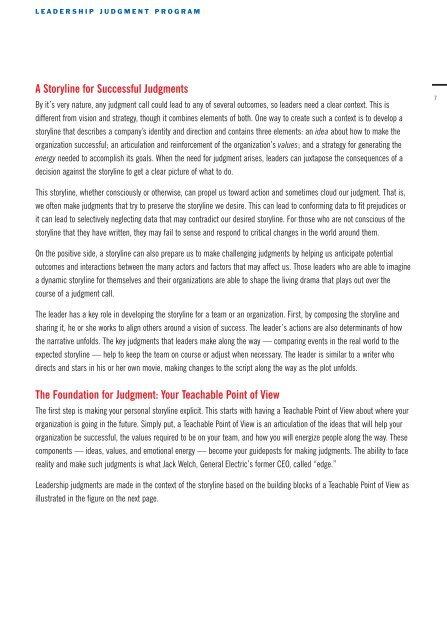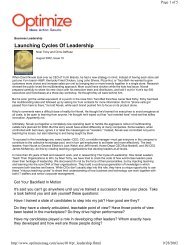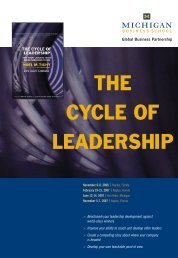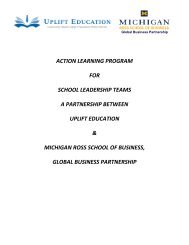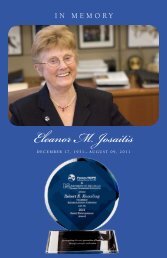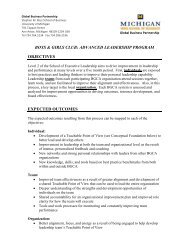June 5-7, 2012 I Ann Arbor, Michigan December 3-5 ... - Noel Tichy
June 5-7, 2012 I Ann Arbor, Michigan December 3-5 ... - Noel Tichy
June 5-7, 2012 I Ann Arbor, Michigan December 3-5 ... - Noel Tichy
You also want an ePaper? Increase the reach of your titles
YUMPU automatically turns print PDFs into web optimized ePapers that Google loves.
LEADERSHIP JUDGMENT PROGRAM<br />
A Storyline for Successful Judgments<br />
By it’s very nature, any judgment call could lead to any of several outcomes, so leaders need a clear context. This is<br />
different from vision and strategy, though it combines elements of both. One way to create such a context is to develop a<br />
storyline that describes a company’s identity and direction and contains three elements: an idea about how to make the<br />
organization successful; an articulation and reinforcement of the organization’s values; and a strategy for generating the<br />
energy needed to accomplish its goals. When the need for judgment arises, leaders can juxtapose the consequences of a<br />
decision against the storyline to get a clear picture of what to do.<br />
7<br />
This storyline, whether consciously or otherwise, can propel us toward action and sometimes cloud our judgment. That is,<br />
we often make judgments that try to preserve the storyline we desire. This can lead to conforming data to fit prejudices or<br />
it can lead to selectively neglecting data that may contradict our desired storyline. For those who are not conscious of the<br />
storyline that they have written, they may fail to sense and respond to critical changes in the world around them.<br />
On the positive side, a storyline can also prepare us to make challenging judgments by helping us anticipate potential<br />
outcomes and interactions between the many actors and factors that may affect us. Those leaders who are able to imagine<br />
a dynamic storyline for themselves and their organizations are able to shape the living drama that plays out over the<br />
course of a judgment call.<br />
The leader has a key role in developing the storyline for a team or an organization. First, by composing the storyline and<br />
sharing it, he or she works to align others around a vision of success. The leader’s actions are also determinants of how<br />
the narrative unfolds. The key judgments that leaders make along the way — comparing events in the real world to the<br />
expected storyline — help to keep the team on course or adjust when necessary. The leader is similar to a writer who<br />
directs and stars in his or her own movie, making changes to the script along the way as the plot unfolds.<br />
The Foundation for Judgment: Your Teachable Point of View<br />
The first step is making your personal storyline explicit. This starts with having a Teachable Point of View about where your<br />
organization is going in the future. Simply put, a Teachable Point of View is an articulation of the ideas that will help your<br />
organization be successful, the values required to be on your team, and how you will energize people along the way. These<br />
components — ideas, values, and emotional energy — become your guideposts for making judgments. The ability to face<br />
reality and make such judgments is what Jack Welch, General Electric’s former CEO, called “edge.”<br />
Leadership judgments are made in the context of the storyline based on the building blocks of a Teachable Point of View as<br />
illustrated in the figure on the next page.


